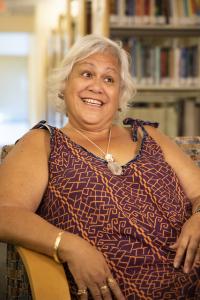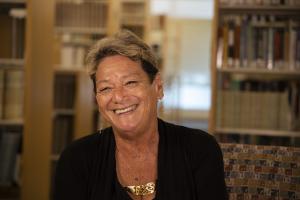Hypertension in Native Hawaiians dramatically reduced by health intervention incorporating hula
UH medical school study presented at national heart association meeting
University of Hawaiʻi at MānoaVideo: https://spaces.hightail.com/space/LnBRQyOsgl
Photographs: https://flic.kr/s/aHsmGvN84L
- Largest-ever health treatment study involving Native Hawaiians is being presented to the National meeting of the American Heart Association this weekend
- UH medical school study shows participants lowered their risk for heart disease
The University of Hawaiʻi at Mānoa John A. Burns School of Medicine (JABSOM) presented results of a five-year study that showed hula significantly reduced hypertension in Native Hawaiian participants. The results were presented September 7, at the American Heart Association national meeting.
JABSOM researchers recruited 263 Native Hawaiians in nine communities on three islands. All were given three-hour sessions of hypertension education that included information on diet, exercise and the use of medications. Then, participants were randomly assigned to a control group that received no additional intervention, or to a hula intervention.
Hula participants attended one-hour group hula classes twice a week for three months, followed by one monthly lesson for three additional months with self-directed practice, as well as group activities to reinforce hypertension education and healthy behaviors. All participants continued their usual medical treatment during the study.
Those who participated in the program incorporating hula lowered their blood pressure far below what those who were not assigned to the hula intervention were able to accomplish. They significantly reducing their 10-year risk of getting heart disease and they were able to sustain improvements in their blood pressure after one-year -- which was six months after the study’s hula classes ended. The participants reduced their systolic (top number) blood pressure by an average of 17 points.
“I don’t want to say I would be dead, but I would have probably had a heart attack or stroke by now, because I know exactly what I didn’t do,” said Arma Oana, a study participant. “I didn’t exercise until I came to the program. I didn’t think I could.”
Principal Investigator for the study Keaweʻaimoku Kaholokula, chair of the medical school’s Department of Native Hawaiian Health (DNHH), said his researchers have found that Native Hawaiians want group-based and culturally relevant lifestyle interventions that resonate with their cultural values and perspectives.
“Hula is fun, it’s something you can do at an older age as well as a young age,” said Kaholokula. “It can be adjusted, modified for people with different physical capacity. You can do the Merrie Monarch competition duck walks for younger people and you can do the slower, gentle side-to-side (motion) for older folks; so I think it’s a type of physical activity that makes sense, that we can really use for health promotion.”
Co-Investigator Mele Look emphasized that more than just the hula movements was at work improving the participants’ health.
“What the kumu hula (teachers of hula) have been telling us is that hula integrates your mind, body and spirit. The hula environment creates really strong social connections between the kumu and the participant and the participants with each other, and all that together helped reinforce them to make changes in their lifestyle; maybe improve their commitment to taking their medications, inspire them to continue practicing the hula, even the stress management component -- knowing you have friends supporting you,” said Look, DNHH director of community engagement. “Hula is great for your health, mind, body and spirit.”
Ten kumu hula were involved in the study, guided by Mapuana de Silva from Hālau Mōhala ʻIlimia, who partnered with the researchers. Six community organizations joined the study, named The KaHOLO Project. Before the research was presented to the AHA in New Orleans on September 7, the researchers met with participants in Hawaiʻi to inform them of the results and congratulate them on their success.
One of the study participants, Luana Albino of Waimanalo said, “When I lost my first two pounds I thought, ‘Wow, I’ve been trying forever to lose weight and I couldn’t’. I saw my blood pressure and diabetes (go down).”
The study was funded by the National Heart, Lung, and Blood Institute of the National Institutes of Health. DNHH is the only clinical department within an accredited U.S. medical school specifically dedicated to the health of an indigenous people. Its researchers believe being asked to share their findings at the heart association convention is an acknowledgement of their work and a sign that health officials nationwide are realizing that to improve health in minority populations it helps to address those populations in ways that are culturally relevant to them, ways that meet them where they are in their communities.
“This study is a great example of how interventions can be more effective when they are tailored for cultural relevance to participants,” said the American Heart Association’s Chief Medical Officer for Prevention Eduardo Sanchez. “Not only are individuals achieving health-promoting levels of physical activity, they are also having fun, engaging in a valued cultural practice, and connecting with their community in the group classes — all important for well-being. This is an approach that can easily be applied to other groups and dancing styles, such as ballroom dancing, line dancing or salsa dancing, and supports the American Heart Association’s philosophy to meet people where they are to help them live longer, healthier lives.”
Kaholokula, lead study author, said partners in the study already are hoping to convince health insurance companies to offer coverage similar to that currently offered for gym memberships for certified programs that incorporate hula to reduce heart disease.
Co-authors of the KaHOLO Project study are Tricia M. Mabellos, Dr.P.H.; So Yung Choi, M.S.; Todd B. Seto, M.D.; Thomas Wills, Mapuana de Silva, B.A., Ph.D.; Adrienne Dillard, Ph.D., M.S.W., L.S.W.; Joseph Gonsalves, B.A.; A. Aukahi Austin Seabury, Ph.D.; J. Kahaulahilahi Vegas, M.P.H.; Stacy L. Haumea, D.B.H., R.D.N., L.D., C.D.E.; Donna-Marie Palakiko, Ph.D.; and Mele A. Look, M.B.A.
VIDEO: https://spaces.hightail.com/space/LnBRQyOsgl
SOTs:
Dr. Keaweʻaimoku Kaholokula, Professor, Chair of the Department of Native Hawaiian Heath
John A. Burns School of Medicine
0:03 to 0:25
“Itʻs fun, itʻs something you can do at an older age as well as a young age. It can be adjusted, modified for people with different physical capacity. You can do the Merrie Monarch competition duck walks for younger people and you can do the more slower, gentle side to side for older folks so I think it’s a type of physical activity that makes sense, we can really use for health promotion.”
Mele Look, Director of Community Engagement, Department of Native Hawaiian Health
John A. Burns School of Medicine, Co-investigator of the KaHOLO Project
0:28 to 0:47
“Broader than Hawaiʻi, that across the nation they’re realizing that if we want changes in improvement in health especially for minority populations, we have to address them in ways that are culturally relevant to them and in ways that meet them where they are, which is in the community.”
Arma Oana, KaHOLO participant
00:50 to 1:06
“I don’t want to say I would be dead but I would have probably had a heart attack or stroke by now, because I know exactly what I didn’t do. I didn’t exercise until I came to the program, didn’t think I could.”
Luana Albino, KaHOLO participant
1:08 to 1:21
“It’s wonderful and the people of Waimanalo, all of my friends, they love it. It gets you involved with other people, it gets you moving, and you’re doing your own culture, yeah.”
BROLL:
1:49 to 1:55 Medium shot hula
1:56 to 2:03 Wide shot hula
2:04 to 2:07 hula from low angle
2:07 to 2:21 Hula from low angle
2:21 to 2:31 Wide shot, large group hula
2:31 to 2:36 Close up feet and skirts
2:36 to 2:43 Panning left, wide shot of hula group at the front of the room
2:43 to 2:48 Close-up of arms and hands hula
2:49 to 2:56 Wide shot of hula from the left
2:57 to 3:03 Wide shot shows audience from back of the room
3:04 Close-up of diagram showing decrease in blood pressure throughout 6 months
3:07 to 3:13 Close-up of Keawe speaking to the audience
3:13 to 3:17 Woman in audience claps
3:17 to 3:27 Wide panning of the entire room
3:28 to 3:31 Close-up of audience
3:31 to 3:34 Close-up of audience, including Luana Albino, who was a participant that we interviewed.
3:35 to 3:40 Audience
3:40 to 3:42 Audience
3:43 to 3:49 Woman speaks at the front of the room
3:49 to 3:54 Keawe presents his slides
3:54 to 4:00 Pan close-up of audience listening intently



